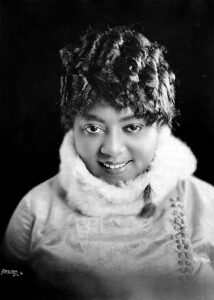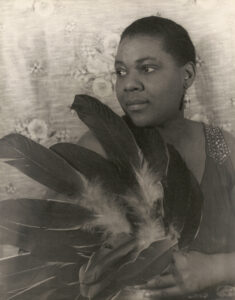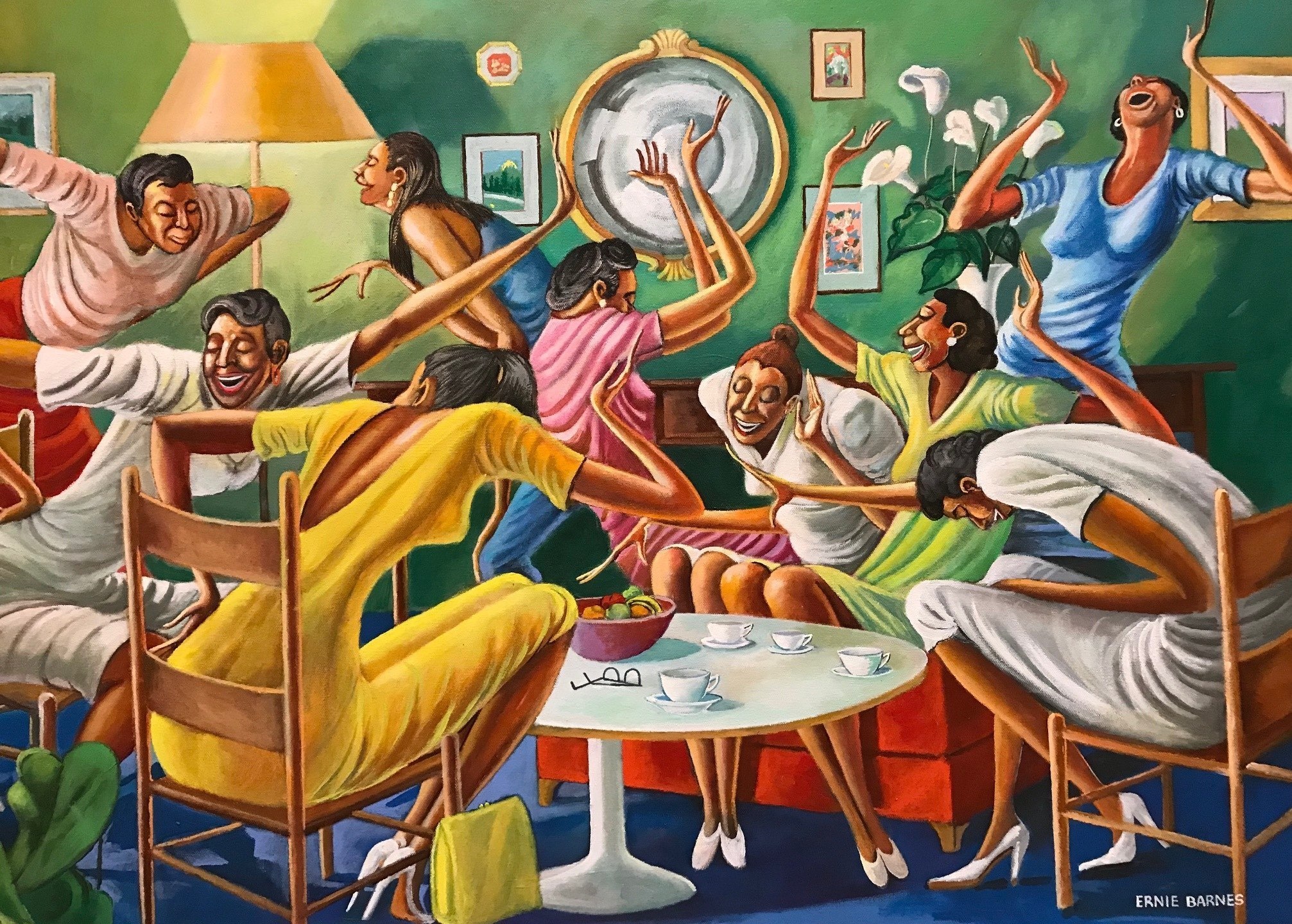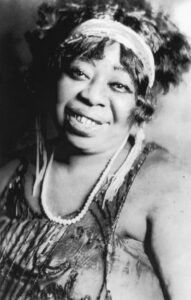(Art by Ernie Banks: If You’re Black Get Back)
By Gwen McKinney
This month we celebrate the far-flung majesty of Black music by paying homage to three pioneers. Musical royalty, they were all late 19th Century contemporaries who staked out their legendary portraits: the First Lady of Blues Mammie Smith, the Mother of Blues Ma Rainey, the Empress of Blues Bessie Smith.
Singularly and collectively – each defies comparisons – they inhabited sounds that have moved, transformed and inspired us through the decades and the ages. Despite the racist and sexist exploitation of the music industry, these women laid the foundation for mega superstars like Beyoncé and Rhianna who command their brand and music.

Credit: Confetta
Mamie Smith (1891-1946), born Mamie Robinson in Cincinnati, OH., soared into the musical stratosphere in 1920 as the first Black artist to record blues music.
Beginning show business at 10, Smith seamlessly traveled from vaudeville tours as a dancer and singer to the recording studio and then stage and even film with a stint of low-budget movies.
Scoring commercial success with her most popular record Crazy Blues sold 75,000 copies in the first month of release. While other recordings had preceded Smith’s hit record, its ascent was attributed to teaming with the Jazz Hounds, an all-Black band which Smith toured with during performances of the 1920s.
Songwriter and composer Perry Bradford is credited with Smith’s biggest hits. Spotting Mamie’s stage and voice prowess during vaudeville shows, it was Bradford who convinced Okeh Records to sign her with a recording deal. Crazy Blues, released in August 1920, sold a million copies in less than a year. The phenomenal sales convinced executives of the budding recording industry that Black artists were great for their bottom line.
Most of her recorded music was purchased by Black fans who fully embraced the 1920s and 1930s sounds called “race records.” During the same era, White artists attempted to record blues sounds but never reached stardom.
The Union, Cincinnati’s Black newspaper, extolled Smith’s sensational rise: “Mamie has done more than any other singer…to popularize the genuine ‘blues’ songs of the day. In her hands a song like ‘Crazy Blues’ … becomes (a) living, potent thing…never before equaled by any singer of this type in this country.“
Mamie donned diamonds and pearls to accent her glamourous stage presence. Married three times with no children, she settled into a swank Harlem residence, reportedly among the first Black women to actually purchase a home there.
Smith, reportedly going broke in the stock market crash of 1929, died penniless and was consigned to an unmarked grave on Staten Island. As a result of an online fundraising campaign, she finally received a headstone in 2013.
Decades after her passing, Mamie Smith’s Crazy Blues would be inducted into the Grammy Hall of Fame in 1994. The tune was selected for preservation in the National Recording Registry of the Library of Congress in 2005.
Gertrude “Ma” Rainey (1886 – 1939), called the Mother of Blues, started performing around the age of 14. After her
marriage to Will “Pa” Rainey in 1904, she appropriated “Ma” as the calling card she’d carry (Ma & Pa Rainey) even after her divorce from Will Rainey.
Beyond the Black minstrel circuit, Ma performed wherever Black people gathered, in the fields and tent shows throughout the South, and eventually in stage shows and recording studios in the big cities of Chicago and New York.
Rainey claims to have created the term “Blues Music” leaning into the concept with her full-throated croons and wails. She commanded a bawdy, get-down-low-and-dirty style that catapulted her into recording stardom.
For Paramount Records she cut her first record in 1923 and produce almost 100 singles over five years that won her national acclaim, setting a standard of Blues vocals that would be replicated and evolve throughout the 20th Century.
Openly bisexual, Ma Rainey created a style that few could emulate. She traveled with heavy bling – sequins, feathers, gold chains and gold teeth – revisited in the trappings of 21st Century rappers.
The two other 19th Century Blues Queens garnered greater commercial success, but Ma Rainey’s grit and audacity were incomparable. She held court for up-and-coming brothers like a young “horn man” named Louise Armstrong. In 1924, he joined Ma Rainey to perform one of her major hits, See See Rider. He reportedly incorporated some of her showy mannerisms into his own stage demeanor.
Dropped by Paramount in 1933 – record executives claimed her “down-home” style had played out – she returned to her native Georgia in 1933. Refusing to quit show business and the music that she birthed, she launched two theaters and ran them until she died of a heart attack six years later.

By Carl Van Vechten, restored by Adam Cuerden – This image is available from the United States Library of Congress’s Prints and Photographs division
Bessie Smith (1894 –1937) was renowned for her show-woman pizzazz, winning the title “Empress of the Blues.” Through her recording, touring and stage gigs, she was considered the most popular female blues singer of the 1930s.
Born in Chattanooga, Tennessee, Smith was orphaned at nine. Survival for her and six siblings was eked out by panhandling during street corner performances. Her touring career began with a traveling group headlined by Ma Rainey who she befriended and emulated.
Bessie, signed with Columbia Records in 1923, surpassed Ma Rainey and Mamie Smith’s success as the highest-paid black entertainer of her day. Her traveling shows included whistle-stop extravaganzas in a 72-foot-long railroad car.
Smith’s music centered storytelling that celebrated independence and sexual freedom. Like her mentor Ma Rainey, she was openly bisexual and refused to be bound by restrictions of gender identity, norms and practices.
The light of that rising star was tragically extinguished at 43 during a fatal car crash. Reportedly a victim of a highway accident involving a Nabisco truck, she bled out on a country road where her body was tossed on impact from the collision. Reports indicate that she never received emergency medical attention.
Posthumously inducted into the Rock and Roll Hall of Fame in 1989, Bessie soared in an era when blues and jazz were enjoying a crossover sensation, influencing a generation of the greatest women music makers of the 20th Century including Etta James, Mahalia Jackson, Billie Holliday, Ella Fitzgerald and legions of artists who swapped their full-throated blues for jazz standards, swing, folk, R&B and rock.
Buried in an unmarked grave near Philadelphia, Bessie Smith received a headstone in 1970, paid for by singer/songwriter Janis Joplin who credits the Empress of Blues as her foremost influence. The tombstone inscription reads: “The Greatest Blues Singer in the World Will Never Stop Singing.”
Gwen McKinney is the creator of Unerased | Black Women Speak, a public engagement initiative dedicated to amplifying voices and interests of Black women.




